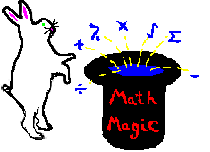



A. This sequence is sometimes referred to as Triangular Numbers, and can be solved by the equation:
1 + 2 + ... + n = n (n+1)
2
B. Using numbers instead of variables we get the following:
1. Multiply the last number by that number plus 1, then divide by 2.
2. Notice one of these numbers is divisible by 2, so you can divide the even number by 2 and then multiply by the other number.
Ex [1] 1 + 2 + ... + 10 =_________.
a) From the equation we know this is equal to: (10 x 11) / 2 or 5 x 11 = 55.
b) The answer is 55.
Ex [2] 1 + 2 + ... + 50 =_________.
a) From the equation we know this is equal to: (50 x 51) / 2 or 25 x 51 = 1275. See Multiplying by 25.
b) The answer is 1275.
C. Sometimes there might be a number missing to throw you off, so you need to be careful.
Ex [3] 2 + 3 + 4 + ... + 25 =_________.
a) Notice that the number 1 is missing from the equation. Treat it as though it were there.
b) From the equation we know this is equal to: (25 x 26) / 2 or 25 x 13 = 325.
c) Since the number 1 is missing, you should subtract 1 from 325. The answer is 324.